Ever had a bagel that smelled like the kitchen had been sprinkled with sunshine? That’s what happens when you make these Vegan Garlic Herb Bagels with Olive Oil. The kitchen fills with that warm, zesty aroma and suddenly breakfast feels like a small ceremony. You’ll be surprised how simple ingredients and a little patience turn into something downright unforgettable.
I still remember the first time I swapped butter for olive oil in dough. It felt a bit rebellious. But the result? A softer crumb and a rounded, fruity note that plays brilliantly with garlic and fresh herbs. These bagels are chewy where they should be, pillowy in the middle, and glazed with a subtle sheen from that olive oil. They’re perfect warm with a smear of vegan cream cheese, or halved and toasted for a crunchy edge that sings.
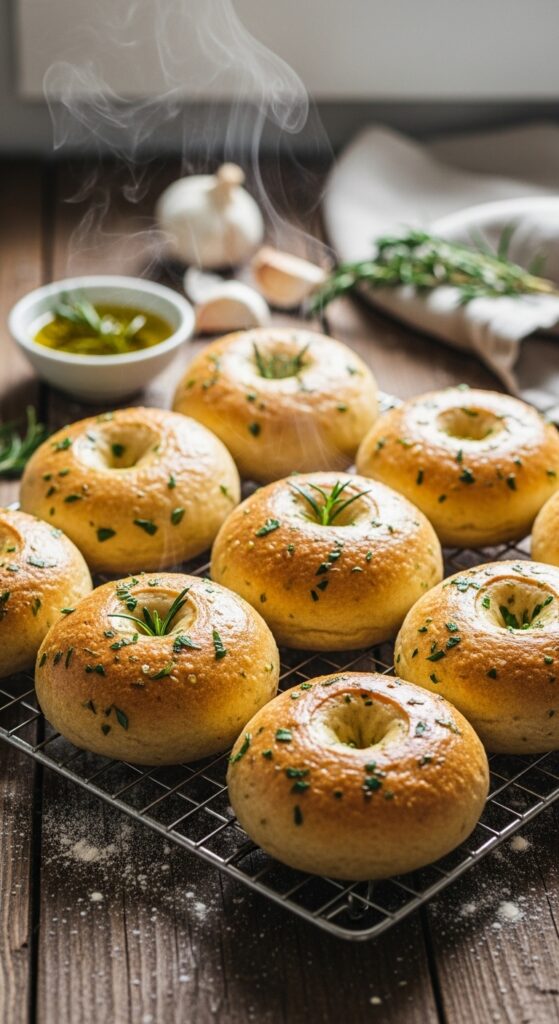
Why It’s Special

Bagels have a reputation for being fussy, but once you know the why behind each step, it’s oddly soothing. The brief boil before baking is the trick that gives bagels their signature chew and gloss. Olive oil—yes, olive oil—replaces richer fats and keeps the interior tender, while adding a bit of Mediterranean brightness.
The garlic and herb combo makes this bagel more than a vehicle for toppings. It’s an aromatic, savory bread that can stand on its own. Think of it as a savory little loaf that moonlights as the best sandwich bread you’ve ever met. They’re vegan without being preachy. They’re accessible without being boring. And they travel well—great for gifting, picnics, or a lazy Sunday brunch.
There’s also a cultural nudge here. Bagels were born in Eastern Europe and became iconic in New York, but this version nods to Mediterranean flavors—olive oil, garlic, rosemary—so you get a cross-continental handshake in every bite.
Ingredients & Substitutions
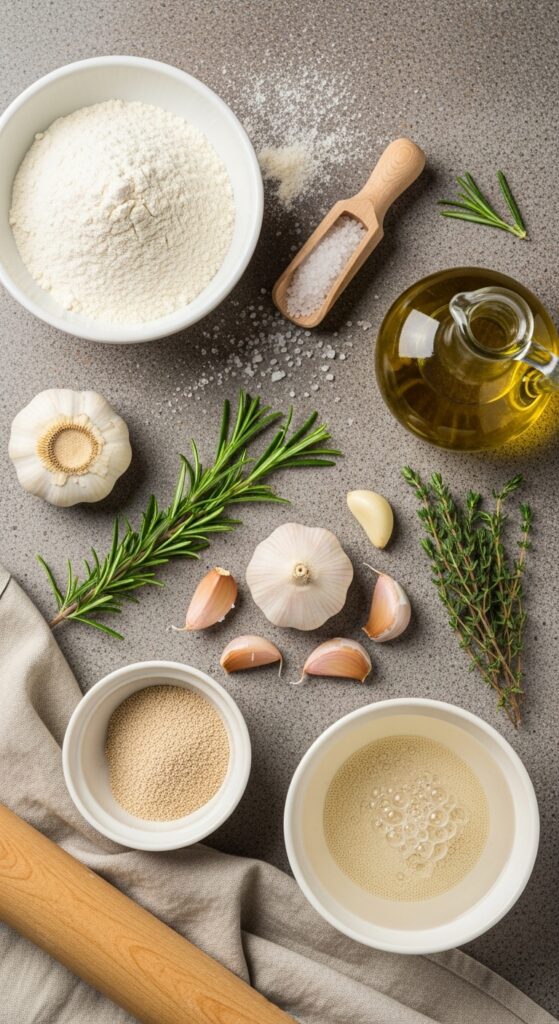
You’re going to want good basics. They don’t need to be fancy, but they should be honest. The flour, the olive oil, the herbs—those are the notes that sing. Below is a logical list, followed by swaps and chef tips.
Essentials:
- 3 ½ cups (420g) bread flour, or all-purpose if that’s what’s in your pantry. Bread flour yields a chewier bite.
- 1 packet (2 ¼ tsp / 7g) instant yeast. If using active dry yeast, proof it in warm water first.
- 1 cup (240ml) warm water, about 105–110°F (just warm to the touch).
- 2 tbsp (25g) granulated sugar or maple syrup. Yeast food and crust color.
- 1 ½ tsp (9g) fine salt.
- 3 tbsp (45ml) extra virgin olive oil, plus more for brushing.
- 4 cloves garlic, finely minced, or 2 tbsp roasted garlic for a mellower flavor.
- 2 tbsp finely chopped fresh herbs (rosemary, thyme, parsley). Use dried at one-third the amount.
- 1 tbsp sugar or maple syrup for the boiling water (creates glossy crust).
Substitutions & swaps:
- Flour: Whole wheat up to 1 cup for a nuttier, denser bagel. For gluten-free, use a 1:1 GF blend with xanthan gum—expect a different chew but still delicious.
- Yeast: Active dry yeast works; bloom in 1/4 cup warm water with a pinch of sugar for 5–10 minutes.
- Sugar: Honey is not vegan, but maple or agave work fine.
- Olive oil: Avocado or light-tasting vegetable oil if you want a milder profile.
- Herbs: Swap rosemary for basil, oregano, or dill. Fresh is best for aroma. If using dried, reduce quantity because dried is more concentrated.
- Garlic: For a softer, caramelized note, roast the garlic and use that instead.
Expert ingredient tips:
Fresh herbs release volatile oils when chopped; do it right before adding to the dough to capture the aroma. For garlic, finely mince to disperse flavor; if you prefer little roasted pockets of sweetness, fold in soft roasted cloves later in shaping instead of raw garlic in the dough. Use a digital scale if you have one—baking is about balance and consistency.
Step-by-Step Instructions
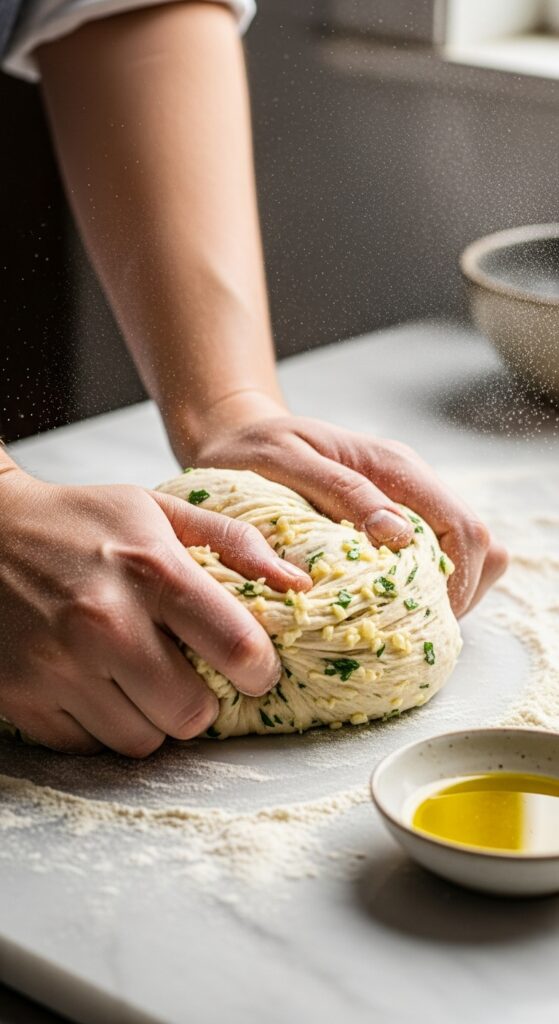
This is the rhythm: mix, knead, rest, shape, boil, bake. Each step has a reason. Follow these and you’ll be rewarded.
- Prepare yeast (only if using active dry): Stir active dry yeast into 1/4 cup warm water with 1 tsp sugar. Let sit until foamy, about 5–10 minutes. If using instant yeast, mix dry right into the flour and proceed without proofing.
- Mix dry ingredients: In a large bowl, whisk the flour, remaining sugar, and salt. Add minced garlic and chopped herbs—reserve a pinch of herbs for finishing.
- Add wet ingredients: Make a well and pour in the warm water, olive oil, and the proofed yeast (or sprinkle instant yeast in). Stir with a wooden spoon until a shaggy dough forms.
- Knead: Transfer to a floured surface or use a stand mixer with dough hook. Knead 8–10 minutes by hand, or 6–8 minutes in the mixer, until smooth and elastic. The dough should be slightly tacky but not sticky. Add flour sparingly—too much makes dense bagels.
- First rise: Oil a clean bowl lightly, place the dough inside, cover with a damp towel or plastic wrap, and let rise in a warm spot until doubled, about 1 hour. Underproofing yields dense bagels; overproofing makes them collapse in the boil.
- Shape the bagels: Punch down gently to deflate. Divide into 8 equal pieces (about 95–110g each). Roll each piece into a ball, then poke a hole through the center with your thumb and gently stretch to form a ring roughly 2–3 inches across. Keep them slightly smaller than you want finished; they’ll puff in the boil and oven.
- Second rest: Place shaped bagels on a parchment-lined tray. Cover loosely and let rest 20–30 minutes. They’ll puff slightly.
- Preheat the oven: 400°F (200°C). Line another tray or use a baking stone if you want a crisp bottom.
- Boil: Bring a large pot of water to a gentle boil and add 1 tbsp sugar or maple syrup. Carefully drop bagels into the water, two to three at a time to avoid crowding. Boil 30–40 seconds per side. Turn once with a slotted spoon. Longer boil = chewier crust; shorter boil = softer.
- Top & bake: Remove boiled bagels to the tray. Brush tops with olive oil; sprinkle reserved herbs, sea salt, or sesame seeds. Bake 18–25 minutes until golden and fragrant.
- Cool: Let cool on a wire rack at least 10 minutes before slicing. Cutting too early translates to gummy crumb.
Professional tips and common mistakes:
- Don’t over-flour while kneading. Keep a little tackiness.
- Boil at a gentle simmer; too vigorous and bagels can tear.
- Proof time depends on your kitchen temperature. Cooler rooms need longer.
- If you want glossy, brush with oil after baking; for extra sheen use a dairy-free egg wash alternative like aquafaba (chickpea liquid) if you enjoy that glossy bakery look.
- Shape consistently. Size variations mean uneven baking.
Variations:
- Spicy: Add 1/2–1 tsp red pepper flakes to the dough and finish with chili oil.
- Everything-Herb: Mix sesame, poppy, dried onion, and a pinch of garlic powder for an everything-like topping.
- Stuffed: Flatten portions of dough, add roasted mushrooms or vegan cheese, then enclose and seal before shaping into rings.
- Mini bagels: Divide into 12–14 pieces, boil 20 seconds per side, and bake 12–15 minutes.
Cooking Techniques & Science
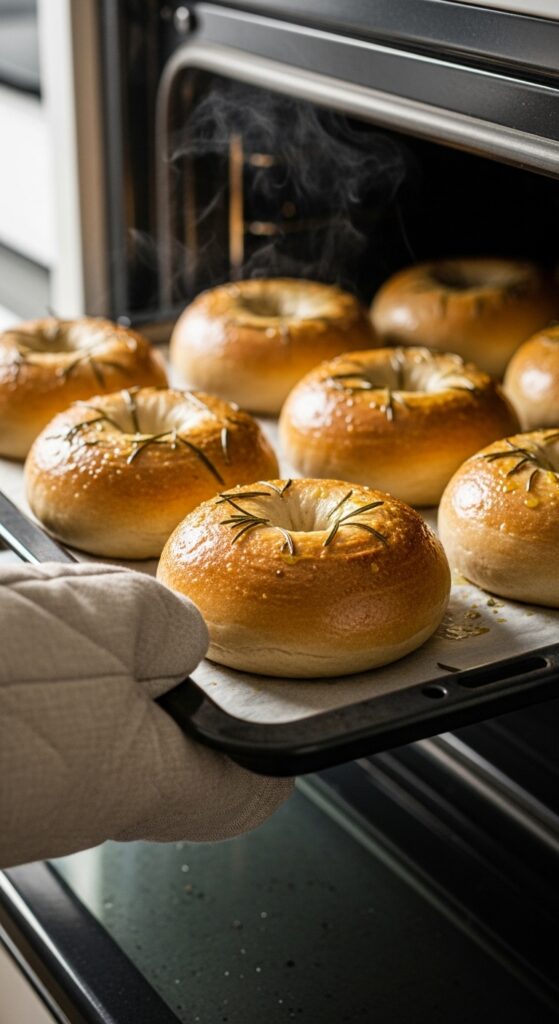
Let’s nerd out a bit. There’s a straightforward science to what makes bagels bagels.
Boiling sets the crust. When you plunge dough into hot water, the starches on the surface gelatinize, creating a layer that becomes dense and gleaming once baked. That’s why store-bought bagels have that distinct chew and sheen—boil is non-negotiable for authentic texture.
Kneading develops gluten. The mechanical action aligns gluten strands and creates an elastic network that traps gases from yeast fermentation. That elastic network is what gives bagels their bounce and chew. Over-knead and the dough gets tough; under-knead and it won’t hold structure.
Olive oil moderates crumb softness. Traditional bagels often use no added fat. Adding olive oil makes the crumb softer and the mouthfeel richer. It also brings flavor. Extra virgin olive oil contributes fruity, peppery notes that harmonize with garlic and herbs.
Herbs and garlic timing matters. Fresh aromatic compounds are delicate. Adding them too early in heavy kneading can smear or tear gluten strands, slightly compromising structure. That’s why I recommend adding them after initial mixing and doing only a brief knead to incorporate. Alternatively, fold them in late in the knead, gently.
Tools and their impact:
- Stand mixer: Consistent knead and less arm fatigue.
- Digital scale: Consistency in bread is a superpower.
- Slotted spoon: Makes transferring from boil to tray easy and safe.
- Baking stone: Mimics hearth baking and crisps the bottom quickly.
- Metal pot with wide mouth: Prevents crowding in the boil and makes turning easier.
Cultural context:
Bagels arrive from a long tradition of ringed breads across cultures—from bublik to simit. The boil-then-bake technique is a hallmark of the Ashkenazi Jewish bagel tradition. This recipe borrows that method but moves the flavor profile toward the Mediterranean with olive oil, garlic, and rosemary. The result is a hybrid that feels both comfortingly classic and pleasantly new.
👉 Recipe Card
Vegan Garlic Herb Bagels with Olive Oil
Prep Time: 20 minutes
Cook Time: 25 minutes
Rising Time: 1 hour 30 minutes (includes two rests)
Total Time: approximately 2 hours 15 minutes
Servings: 8 bagels
Ingredients:
- 3 ½ cups (420g) bread flour or all-purpose flour
- 1 packet (2 ¼ tsp / 7g) instant yeast (or active dry, proofed)
- 1 cup (240ml) warm water (105–110°F)
- 2 tbsp (25g) sugar or maple syrup
- 1 ½ tsp (9g) salt
- 3 tbsp (45ml) extra virgin olive oil, plus more for brushing
- 4 cloves garlic, finely minced (or 2 tbsp roasted garlic)
- 2 tbsp finely chopped fresh herbs (rosemary, thyme, parsley)
- 1 tbsp sugar or maple syrup for boiling water
- Optional toppings: coarse sea salt, extra chopped herbs, sesame or poppy seeds
Instructions:
- If using active dry yeast, proof yeast in 1/4 cup warm water with 1 tsp sugar until foamy, 5–10 minutes. If using instant yeast, sprinkle into the dry flour.
- In a large bowl, whisk flour, 2 tbsp sugar, and salt. Stir in minced garlic and most of the chopped herbs, reserving a pinch for topping.
- Add warm water, olive oil, and the proofed yeast (or combine instant yeast into the mix). Stir until a shaggy dough forms.
- Knead by hand on a lightly floured surface 8–10 minutes, or in a stand mixer 6–8 minutes, until smooth and elastic.
- Place dough in an oiled bowl, cover, and let rise in a warm place until doubled, about 1 hour.
- Punch down dough and divide into 8 equal pieces. Shape each into a smooth ball, then poke a hole through the center and form a ring about 2–3 inches across.
- Place on a parchment-lined tray, cover loosely, and rest 20–30 minutes.
- Preheat oven to 400°F (200°C). Bring a large pot of water to a gentle boil and add 1 tbsp sugar or maple syrup.
- Boil bagels 30–40 seconds per side, working in small batches. Transfer to the tray, brush with olive oil, and top with reserved herbs or seeds.
- Bake 18–25 minutes until golden brown. Cool on a wire rack at least 10 minutes before slicing.
Nutrition per serving (approximate):
Calories: 230
Fat: 5 g
Carbohydrates: 38 g
Protein: 7 g
Fiber: 2 g
Serving & Pairing Suggestions
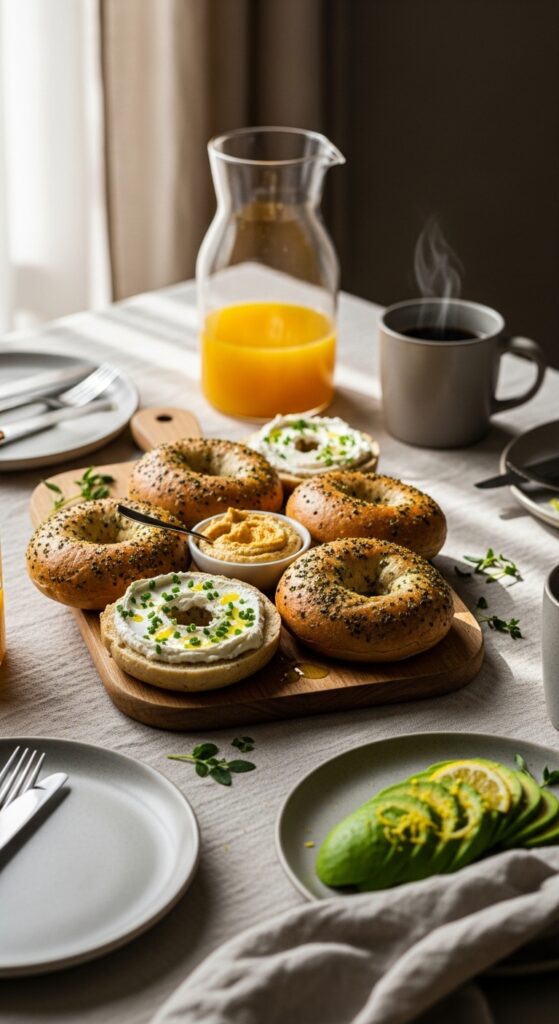

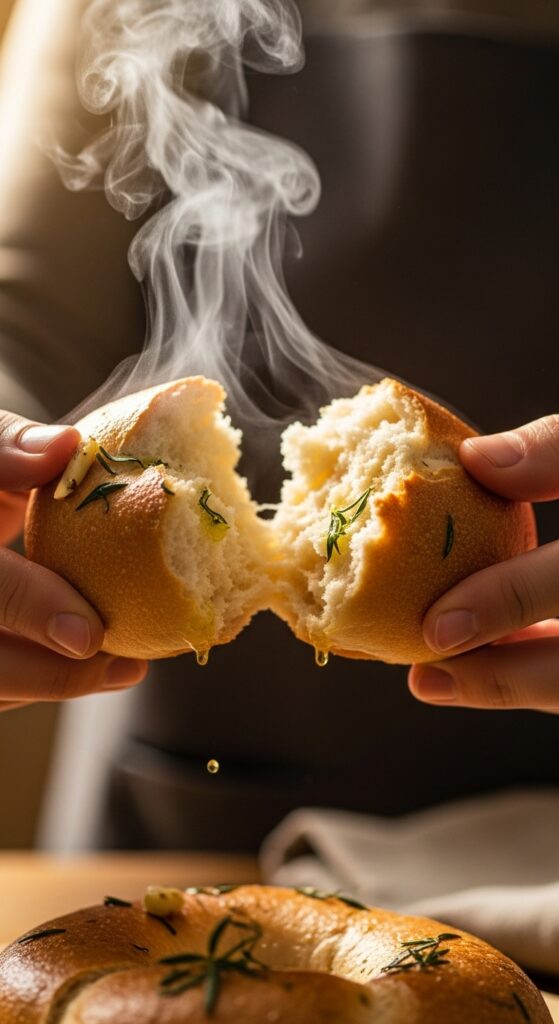
These bagels love simplicity. Warm one, brush with a little extra virgin olive oil, and eat it plain. That olive oil + garlic + herb whisper is intoxicating.
For spreads, vegan cream cheese is a natural match. Add lemon zest and chives to the spread for a bright contrast. For a heartier bite, layer with smashed avocado, lemon, a pinch of chili flakes, and fresh arugula. Tofu scramble, roasted tomatoes, and spinach make a brilliant breakfast sandwich that travels well.
For a Mediterranean plate, slice and toast bagels, then top with hummus, marinated artichokes, roasted red peppers, and a sprinkle of kalamata olives. The savory herbs and garlic in the bagel play perfectly with those flavors.
Drinks? Keep it fresh. Cold brew coffee for the morning, herbaceous green tea in the afternoon, or a sparkling citrus water with a sprig of rosemary for brunch. If you’re pairing for an adult brunch, a dry sparkling wine or a light white like Pinot Grigio complements the herbaceous notes.
For plating, slice bagels in half and arrange on a wooden board with small bowls of toppings—vibrant avocado mash, roasted peppers, pickled red onions, and a bowl of herb oil for dipping. Sprinkle microgreens or extra herbs on top for color and freshness.
Conclusion
Homemade bagels are one of those kitchen wins that feel far more impressive than they should. They require focus, not fuss. A little knead, a little boil, and you get a golden, aromatic bagel that’s both comforting and sophisticated.
The olive oil gives a tender crumb and a nuanced fruitiness that plays so well with garlic and herbs. These bagels are flexible: make them plain, spice them up, stuff them for sandwiches, or go mini for parties. They freeze beautifully, travel well, and are an excellent way to show someone you care without trying too hard.
If there’s one key tip to take away, it’s this: respect the boil. That brief step is the difference between a roll and a bagel. Beyond that, have fun. Tweak the herbs, try roasted garlic next time, or fold in some olives for an extra Mediterranean punch. Baking should be a little messy and a lot rewarding.
FAQs
How long can I keep these bagels at room temperature?
You can keep them in a paper bag or loosely wrapped for up to 2 days at room temperature. For longer storage, freeze fully cooled bagels in an airtight bag for up to 3 months.
Can I make the dough the night before?
Yes. After the first rise, punch the dough down, place it in a lightly oiled bowl, cover tightly, and refrigerate overnight. Let it come to room temperature for about 30–60 minutes before shaping, then proceed with shaping, boiling, and baking.
My bagels turned out gummy inside. What went wrong?
Gummy crumb often results from underbaking or cutting too soon. Make sure they’re fully baked and allow them to rest 10–15 minutes on a rack before slicing. Also, avoid adding too much flour during kneading which can throw off hydration.
Can I skip boiling if I’m short on time?
Skipping the boil changes the texture dramatically. You’ll get a bun rather than a bagel—fine in a pinch, but not the classic chewy bite. If time is tight, consider making a simpler olive oil-herb roll instead.
What’s the best way to reheat frozen bagels?
Toast straight from frozen for a crisp exterior and warm interior. For a less-toasty option, thaw for 30–60 minutes and then warm in a 350°F oven for about 5–7 minutes.
If you want, I can add short image prompts for each major step—shot ideas for blog posts or Pinterest pins like “close-up of glossy boiled bagels” or “crumb cross-section with olive oil sheen.” Want those added in-line where they’ll help a recipe post?

Selena is an experienced lifestyle blogger and the voice behind many of Cozy Toned’s inspiring posts. With a passion for mindful living, home styling, and everyday wellness, she shares practical tips and fresh ideas to help readers live beautifully and intentionally.